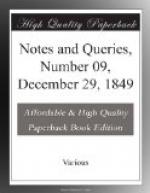authorities, such as Christopher Wren, and others,
who lent their aid in depreciating the old mediaeval
style, which they termed Gothic, as synonymous with
every thing that was barbarous and rude, it may be
sufficient to refer to the celebrated Treatise of
Sir Henry Wotton, entitled
The Elements of Architecture,
4to., printed in London so early as 1624. This
work was so popular, that it was translated into Latin,
and annexed to the works of Vitruvius, as well as
to Freart’s
Parallel of the Ancient Architecture
with the Modern. Dufresnoy, also, who divided
his time between poetry and painting, and whose work
on the latter art was rendered popular in this country
by Dryden’s translation, uses the term “
Gothique”
in a bad sense. But it was a strange misapplication
of the term to use it for the pointed style, in contradistinction
to the circular, formerly called Saxon, now Norman,
Romanesque, &c. These latter styles, like Lombardic,
Italian, and the Byzantine, of course belong more
to the Gothic period than the light and elegant structures
of the pointed order which succeeded them. Felibien,
the French author of the
Lives of Architects,
divides Gothic architecture into two distinct kinds—the
massive and the
light; and as the latter
superseded the former, the term Gothic, which had been
originally applied to both kinds, seems to have been
restricted improperly to the latter only. As
there is now, happily, no fear of the word being understood
in a bad sense, there seems to be no longer any objection
to the use of it in a good one, whatever terms may
be used to discriminate all the varieties of the style
observable either at home or abroad.
J.I.
Trinity College, Oxford.
*
* * * * {135}
DR. BURNEY’S MUSICAL WORKS.
Mr. Editor,—On pp. 63. and 78. of your
columns inquiry is made for Burney’s Treatise
on Music (not his History). Before
correspondents trouble you with their wants, I think
they should be certain that the books they inquire
for have existence. Dr. Burney never published,
or wrote, a Treatise on Music. His only
works on the subject (the General History of Music
excepted) are the following:—
“The Present State of
Music in France and Italy. 8vo. 1771.
“The Present State of
Music in Germany, the Netherlands, and
United Provinces. 2 vols.
8vo. 1775.
“An Account of the Musical
Performances in Westminster Abbey,
and the Pantheon, &c. in Commemoration
of Handel. 4to. 1785.
“A Plan for the Formation
of a Musical Academy, 8vo. n. d.”
As your “NOTES AND QUERIES” will become
a standard book of reference, strict accuracy on all
points is the grand desideratum.
EDW. F. RIMBAULT.
P.S. I might, perhaps, have included in the above
list the Life of Metastasio, which, although
not generally classed among musical works, forms an
admirable supplement to the General History of Music.




